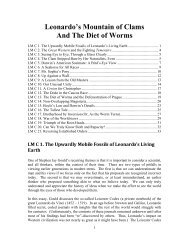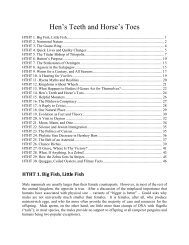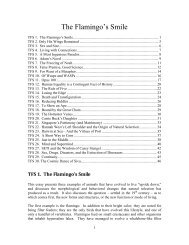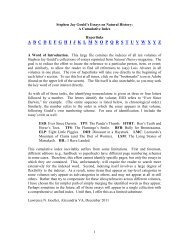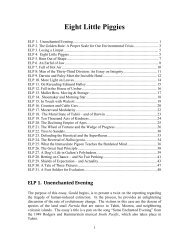cloud (“nebula”) of gas and dust that collapsed under its own gravity. This is interestingfor two reasons. The first is that it is recognized as essentially true today. The second,and the basis for Gould’s essay, is that this represents a historical, one-time-only event,the sort of thing that Laplace detested. Still, the solar system did presumably have toform somehow, and this approach led to a stable configuration. It addressed manyobserved facts: the planets all travel in the same direction about the sun; these orbits alllie close to the same plane; the planets all rotate in the same direction as they travel aboutthe sun (he was unaware of Uranus, which does not); and all the moons rotate in the samedirection as the planets. He developed this theory partially in response to the only otherNewtonian-based model for the formation of the solar system in existence at the time,which belonged to Georges Buffon. <strong>In</strong> 1749, Buffon had proposed that a comet hadstruck the sun, and had ejected a large amount of mass that condensed to form theplanets. This model could account for the first two observed facts discussed above, butLaplace noted that it predicts that some planets and moons should be retrograde(backwards-spinning or backwards-orbiting).For his entire career, with this one famous exception, Laplace remained tuned toproblems with closed, deterministic solutions; those where unique historical events thatpermanently changed the system played no role. Buffon, on the other hand, moved awayfrom the deterministic realm of celestial mechanics to become a naturalist (hence theessay’s title), which he considered to be primarily driven by the quirks of history. One ofhis major works, History and Theory of Earth (1749) [and the first volume of his 44-volume Natural History discussed in LSM 4], was expanded and published late in his lifeas Epochs of Earth (1778). It discusses seven directional periods that the earth hasexperienced. The first epoch is formation, via comet impact with the sun. Others includeformation of the geology and life, culminating with humans. Laplace’s works stay awayfrom inference and anecdotal data wherever possible; Buffon’s is filled with it. Laplace’suniverse is essentially independent of time; Buffon’s is a collection of narrative stories,with beginnings, middles, and ends. Both forms are used and useful in scientific writing,and in Western thinking generally. [Gould’s 1987 book Time’s Arrow, Time’s Cyclediscusses other examples of these metaphors.] While acknowledging the importance ofboth, Gould adds that, as an evolutionist, he is more sympathetic to the narrative camp.He quotes the last paragraph of Darwin’s Origin of Species, which also refers to bothperspectives. It reads:There is grandeur in this view of life, with its several powers, having beenoriginally breathed into a few forms or into one; whilst this planet has gonecycling on according to the fixed law of gravity, from so simple a beginningendless forms most beautiful and most wonderful have been, and are being,evolved.DIH 4. The Late Birth of a Flat EarthAs the title suggests, this essay refutes as myth the widely held view that most scholarsafter the fall of Rome and before the Renaissance believed that the earth was flat. Goulddraws on the book <strong>In</strong>venting the Flat Earth by historian J.B. Russell (1991) for the data.4
There were two minor scholars whose work survives that argued for a flat earth betweenthe years 250 AD and 450 AD. However, all of the giants – Venerable Bede, RogerBacon, Thomas Aquinas, and others – all clearly assumed a spherical earth. Yes, Gouldstates, Columbus had to argue with the clerics of Ferdinand and Isabella, but theargument was not about whether he would sail off the edge of the world, as the tale iscommonly told. It was over the actual size of the Earth, and thus the distance from Spainto Cathay (China) and <strong>In</strong>dia, which the clerics argued (correctly!) that Columbus hadgrossly underestimated. [Columbus died believing that he had reached Asia.]So how and when did the idea that medieval scholars believed that the world was flat takehold? Russell argues that the first generalized claims to this effect took place in the early19 th century, and became widespread in textbooks between 1860 and 1890. One of themain sources was John W. Draper, who wrote a best-selling book called History of theConflict Between Science and Religion, first published in 1874. The other major sourcewas Andrew Dickson White, co-founder of Cornell University and author of the bookHistory of the Warfare of Science with the Theology in Christendom in 1896. Both wrotethat the forces of knowledge and truth, including science, had been fighting against thedogmatism of Christian theocrats for thousands of years, and both used the (essentiallyfalse) flat earth argument as an example. The timing of these books is correlated with theresponse of western culture to Darwin’s book on the theory of evolution (Origin ofSpecies, 1859), in which heated debates between the two communities really did occur.Russell and Gould agree that this is not a coincidence.Gould notes that for most of the past few millennia, science and religion have workedtogether far more than they have fought. The Church, for example, traditionallysponsored work in astronomy, in order to support such tasks as determining the correctdate for Easter. Gould makes the point here and elsewhere [most notably LMC 14] thatscience and religion should have no inherent conflict because they work in differentregimes: science in determining the nature of the universe, and religion in establishingour ethics and morals. Yes, he acknowledges, there have been historical turf wars, butfor the most part the problem has been dogmatism, which has been and continues to be aproblem for both science and religion.DIH 5. The Monster’s Human NatureGould discusses Mary Shelly’s 1818 novel Frankenstein, and the moral lessons that havebeen falsely attributed to it starting with the Hollywood movie of the same name (1931).<strong>In</strong> the Hollywood version, the monster is evil because it was made with an “abnormal,criminal” brain. The implication is that nature, not nurture, is completely responsible forwho we are; this was a commonly held view by the intellectuals at the time the moviewas made [see ESD 28, for example]. The movie version also explicitly states that thestory was a moral tale, warning against the use of science and technology by man to playGod. The actual novel, however, differs completely in this respect. Mary Shelly’screative circle was strongly rationalist, and several members were atheists. The noveldoes not present the moral argument that is attributed to it by the movie. The monsterhimself is not born evil, but rather unformed: he has the capability for both evil and5
- Page 6 and 7: goodness, and is both intelligent a
- Page 9: The second news story involves the
- Page 12 and 13: key ways. Prior to 1994, no fossil
- Page 14: DIH 11. Lucy on the Earth in Stasis
- Page 17: directly resulted in a mass extinct
- Page 20 and 21: Edgar Allan Poe, it turns out, wrot
- Page 22 and 23: things male, while the beautiful is
- Page 24 and 25: interest, until the entrepreneur of
- Page 26 and 27: essay is that scientists, for all t
- Page 28 and 29: DIH 23. The Smoking Gun of Eugenics
- Page 30 and 31: half-Jewish meant Jewish, while qua
- Page 32 and 33: Darwin’s theory, like Adam Smith
- Page 34 and 35: What might a better definition of t
- Page 36 and 37: type of soil, amount of rain, and s
- Page 38 and 39: Case Four, in Gould’s words, is
- Page 40 and 41: multiplying his findings by the num
- Page 42 and 43: other departments, something that r
- Page 44 and 45: Linnaeus, Gould states, did not sim
- Page 46: greatly prefers these metaphors, on




